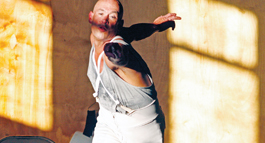home | metro santa cruz index | features | santa cruz | feature story

Photograph by Curtis Cartier
Avant Garde: Daniel Silvernail practices his fencing footwork at the Salle Santa Cruz.
Foil Barons
Good fencers make good neighbors at Santa Cruz's club for swordplay.
By Kat Lynch
THE CLASH of steel and the patter and squeak of athletic shoes fill the Waldorf High School gym. People wearing white and full of energy dance forward and backward, trying to catch their opponents off guard or waiting for the most opportune moment to attack. A beeping sound accompanied by a red or green light on the scoring machine resting on a chair identifies the winner of the point, or touché.
Fencing has been a big part of my life for a while now, so discovering a club is like joining a new family. Everywhere that I have been I have found a fun, comfortable and all-inclusive group of people. Salle Santa Cruz has been around 20 years and is no exception. Whether actively competing or just there for exercise, everyone leaps at the opportunity to meet someone new and test her mettle.
The club fences only foil and epee (pronounced ay-PAY), which descend from the dueling days of old. People fenced foil to train for duels to the death, so only the torso, where many important bodily functions take place, is a valid target. Epee was the dueling weapon and was used for duels to first blood, so the entire body is fair game, including the mask, fingers and toes. Derived from cavalry fighting on horseback, saber--the event of Mariel Zagunis, the only American to win an Olympic gold in fencing--involves a slashing weapon and targets only the waist and above. Today, the blades have been modernized and points are scored with electronic equipment. In the cases of foil and epee, a spring-loaded button and wires tell the scoring box who got a touch. And contrary to the performance of Inigo Montoya in The Princess Bride, bouts are fenced forward and backward on a piste, or strip, 2 by 14 meters in size.
"I was always a fan of the swashbuckling movies," says coach Kevin Osborn with a grin. "My neighbor's dad used to coach. He taught my friend and me finger fencing and some of the basics. I really started up when I got to Humboldt State." As a different form of meditation, fencing has been a part of his life throughout the 30 years since. "You can't think about anything else when you're fencing," says Osborn, who fenced on the national circuit until a couple of years ago.
A couple of months ago the club chipped in to buy new floors for the gym, which is housed in the Garfield Park church on Errett Circle. "It was a group effort between the club, church and a couple of group and sports teams that use the same floor space," says Robin Phillips. My first night at the club, he offered me a foil lesson, which I politely declined as I am an avid epeeist. He started fencing at Texas Tech in 1983 when he saw a sign that said "Reach out and touché someone." Phillips drives up from Monterey two to three times a week to fence at the Waldorf gym.
Four fencing strips are painted in green on the floor, mixed in with the lines for basketball and volleyball. "We painted them ourselves," says Paul Mietz Egli. "Most of what is done with the club is done by volunteers." Mietz Egli, who works as a software engineer by day, started fencing five years ago in San Jose and is currently the club president and director of the Boardwalk Open tournament held each April. It attracts over 100 fencers from all over the West Coast.
"Agility and poise," says tango dancer Daniel Silvernail. "That's the crossover between dance and fencing. If I'm off balance, I don't have point control." Silvernail started fencing saber on the Cal State Northridge team in 1976. "I needed an elective, and it looked interesting on the course list," he says bashfully. Although Silvernail took a break from fencing after college, he started back up again five years ago. Architect by day, fencer and tango dancer by night. What is one thing dancers have over fencers? "They smell nicer," laughs Silvernail.
After footwork, while Osborn gives lessons to those who ask, the rest of the fencers get ready to bout. The club sets up two electronic scoring machines and fences on two of the four strips at a time. Sometimes students from the UCSC club come down for extra practice. "It's fun to surprise the students when they come down and see a bunch of old guys fencing. We kick the daylights out of them," Bob Bailey says proudly. Bailey started fencing in college 45 years ago to meet girls and was very successful--he met his wife at a tournament.
Osborn plans to begin group classes again toward the end of August. "We want to start up new adult and juniors classes," he says. What do they have to say about fencing with beginners? "We fence everybody--it's the only way to learn," Mietz Egli says.
En garde. Ready. Fence! Someone pressures his opponent gradually toward the end of the strip. If both feet go off the end, his opponent gets a free point so he fights back. Fencing shoes squeak and make an irregular sound pattern on the floor--changing up footwork. A dull metallic thump sounds as someone's tip solidly smacks the other's bell guard. A backhand flies out behind for balance with a long, fast lunge. Halt. Touch right.
Who knows? The next Inigo Montoya or Mariel Zagunis might be from Salle Santa Cruz.
Send a letter to the editor about this story.
|
|
|
|
|
|